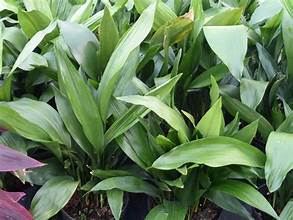How to Successfully Grow and Care for Cast Iron Plant (Aspidistra elatior)

Cast Iron Plant (Aspidistra elatior) has gained recognition for its remarkable tenacity and low maintenance requirements. Its amazing resilience to mistreatment and capacity to flourish in low light levels is reflected in its nickname. Horticulturists now praise it for its low maintenance needs and attractive appearance, which makes cast Iron plant an excellent option for novices and experienced plant lovers both. The plant features eye-catching dark green leaves that lend an air of refinement to any environment, adorned with white stripes running parallel to the veins. Even in the greatest shade, the dense, lush canopy formed by its sturdy, arching leaves thrives.
Because it is hardy and tolerant of irregular watering, the Cast Iron Plant (Aspidistra elatior) was a favourite choice for poorly lit Victorian bar rooms. Even though it grows well in harsh environments, its beauty may be brought to life with the right care. It can withstand droughts and situations when it is pot-bound thanks to its tenacity. This detailed book offers years of experience-based advice on how to easily cultivate and take care of this tough houseplant at home.
Overview of Cast Iron plant
Cast Iron Plant commonly referred to as the bar room plant, is a member of the Asparagaceae family of plants. This perennial houseplant grows well in USDA hardiness zones 7 through 10, making it ideal for indoor conditions. It avoids direct sunlight and favors dim light and deep shadow. Rich, well-drained soil with a pH range of 5.5 to 7.5 is ideal for the plant’s growth, suggesting a mildly acidic to neutral preference. It produces purple and white flowers during its spring and summer blooming. The Cast Iron Plant, which is native to Taiwan and Japan, is prized for its hardiness and versatility in a range of indoor environments.
How to Care for Cast Iron Plant?
Aspidistra elatior, commonly known as the Cast Iron Plant, is a hardy indoor plant that requires little maintenance. It enjoys indirect sunlight coming from a window facing north, and it grows well in low light. Make sure the pot has adequate drainage and use rich, well-drained soil to avoid root rot. Watering at random intervals helps the plant by mimicking the conditions of a natural drought. Cleanse its leaves frequently with a moist cloth, look for pests and treat with horticultural oil or insecticides as necessary.
Light and soil
The hardy Cast Iron Plant (Aspidistra elatior) thrives in deep shade and low light levels, showcasing its adaptability and ease of maintenance. Although it can withstand some direct sunshine, it is best to put it in a north-facing window with diffused light to prevent burning of the leaves. It can withstand sporadic watering, but to avoid root rot, use rich, well-drained soil and make sure the pot has enough drainage. Although soil is resilient, it can be harmful if it is compacted or wet. Use a nutrient-rich potting mix at first for the best growth, especially in the plant’s first growing season.
Water and fertilizer
In order to avoid problems like root rot, the Cast Iron Plant (Aspidistra elatior) needs a pot with adequate drainage. It grows best in soil that drains properly. Because of the fluctuating rainfall in its natural habitat, it can withstand dry spells, but it should not be submerged or overwatered. To help the plant build a robust root system, water when the top inch of soil feels dry. Throughout the plant’s first growing season, keep the soil consistently moist. Apply a light fertilizer once in the spring and once in the summer, using a premium houseplant fertilizer. The plant’s bright green foliage can be preserved using an iron-rich fertilizer. To avoid salt buildup, which can also result in root rot, steer clear of over-fertilization.
Humidity and temperature
The Cast Iron Plant, or Aspidistra elatior, is incredibly temperature-tolerant; it grows best in a cooler climate between 60 to 85°F, though it can tolerate temperatures as low as 45°F. It can withstand low humidity levels found in interior environments and is not sensitive to them. When the weather is really dry, spray the plant softly to keep it healthy and gently brush the leaves down with a damp cloth to keep them glossy.
Pruning
Pruning is essential to preserving the beauty and health of the cast iron plant. The optimum time to do it is when the growth season first begins or when you see damaged leaves. Cut off any leaves that are becoming yellow or browning and return them to the main stem. Use a moist towel to wipe the leaves or give the plant a little watering to control dust. Pruning lowers the chance of insect infestation, stimulates new, healthy development, and helps manage the size of the plant by removing fading or diseased sections.
Varieties of Cast Iron Pant
Variegata: A remarkable variety of Aspidistra elatior, the Variegata has broad green leaves with white stripes running across them, giving it a visually arresting appearance.
Hoshi-Zora: Also called “Starry Sky,” Hoshi-Zora is a gorgeous houseplant with glossy green leaves dotted with yellow. For individuals who value a little something unusual, this is the perfect indoor plant.
Lennon’s Song: A recent addition to the cast iron family, Lennon’s Song is distinguished by its strong white streaks that contrast with its sturdy green leaves.
Asahi: The Asahi cultivar is distinct, having dark green leaves that turn pure white at the tips, giving the impression of snow-capped peaks.
Propagation of Cast Iron Plant
Select a healthy plant
Choose a mature, healthy plant as the first step in propagating a Cast Iron Plant (Aspidistra elatior). Strong green leaves (maybe with white stripes) and little to no dust on the foliage are what you want to see. Regularly wipe the leaves with a moist cloth to keep them clean.
Selection of Rhizome
Cast Iron Plants reproduce by means of their underground stems, or rhizomes. Pick a robust, healthy rhizome that has at least one leaf, and look for any signs of root rot or bugs, as these conditions can be harmful to the young plant.
Prepare pot
To avoid water buildup and root rot, select a pot with several drainage holes. Replicating the natural conditions of the plant by using well-drained soil helps prevent excessive wetness and lowers the chance of pest infestation.
Plant the Rhizome
Plant the rhizome with just enough soil to cover it, in well-drained soil. To replicate the original forest floor conditions of the plant, place the pot near a north-facing window or in a dimly lit spot. The cast iron plant thrives in deep shade and should avoid direct sunlight to prevent burning the foliage.
Make a care routine
In order to prevent infections and dryness during the first growth season, give the Cast Iron Plant regular but moderate watering. It can withstand dry indoor circumstances, but it loves greater humidity levels. To keep pests away, wipe the leaves of the plant with a moist cloth, apply horticultural oil or make your own insecticidal soap.
Monitor growth and nurture
Keep a close eye on the plant during its first growth season to make sure its foliage stays colorful and clear of pests. For those who enjoy indoor plants, this low-light-requiring houseplant is a great option because it requires little maintenance.
How to pot and repot Cast Iron Plant?
Let’s get started with the detailed instructions for potting or repotting this hardy plant.
Step 1. Select the suitable pot
Choose a pot with adequate drainage that fits the expanding rhizomes of the Cast Iron Plant. Make sure there are drainage holes in the pot to avoid water buildup and root rot. Select a container that fits the existing plant or plug one size larger.
Step 2. Prepare your soil
Use a well-drained soil mixture for Aspidistra elatior to thrive as best it can. Mix loam, peat moss, and sand in equal portions; add compost to enrich for extra nutrients. This soil, rich in organic matter, enhances the foliage color and promotes overall plant health.
Step 3. Planting or Transplanting
During the first growing season, place the plant to maximize photosynthesis in the green leaves by providing indirect sunlight, while shielding the white stripes on the foliage from direct sunlight to avoid harm. Before putting the roots in the pot, gently disentangle them.
Common Diseases and pest problems related to Cast Iron Plant
Despite its reputation for resilience, diseases and pests can still affect the cast iron plant. Typical issues consist of:
1. Spider Mites: In particularly dry conditions, these microscopic pests cause white streaks on plants. Clean leaves often with a moist cloth; if necessary, apply horticultural oil or insecticidal soap.
2. Root Rot: Yellowing leaves and stunted growth are the result of inadequate drainage or overly moist conditions. Make sure the plant has adequate drainage and is in well-drained soil.
3. Leaf Spot: A fungus that causes dark patches on leaves; it is frequently brought on by excessive humidity and inadequate ventilation. To control this problem, remove any contaminated leaves and increase ventilation.
Common plant problems and their Solutions related to Cast Iron Plant
White stripes and foliage streaks:
Typically a trait of specific cultivars, such as the Victorian-era bar room plant. These are lovely ornamental elements.
Drought:
The plant still need frequent watering even if it is hardy. Keep up a good watering routine to avoid drought.
Brown Tips:
Frequently brought on by excessive sun exposure or sporadic irrigation. Keep the plant in low light, place it next to a north-facing window, and water it regularly.
Yellowing Leaves:
Usually the consequence of root rot and overwatering. To prevent this problem, make sure the pot has adequate drainage and use well-drained soil.


